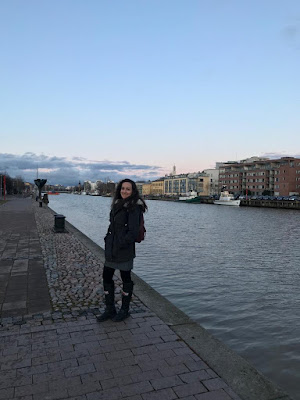First of all, I came to a completely different place and met a different culture.
But I never felt bad because I can never forget the help and interest of the Finnish people.
Because I went abroad for the first time through erasmus. I met a new culture.
What is called culture is the whole of what a society is materially and spiritually distinctive and transfers to future generations. I mostly learned Finnish culture by living, asking and observing.
When I asked someone for help or when I asked for something, they really helped me and they were understanding. Actually, I felt so good that they were humane. Finnish people will always remain respectful, helpful and honest in my mind.
I admire the importance they attach to education. Schools are beautiful and the inside of the school is very friendly. I'm happy the fact that the teachers are understanding and they were interested to me for I am a foreigner. The fact that teachers or students wear booties in the classroom made me feel more sincere in the learning environment. The teachers were very helpful and highly focused on teaching.
I also liked their food. Some dishes were very suitable for my taste. That's why I didn't feel very foreign about this.
The fact that everyone, including young and old, is reading and working in the libraries is a perfect.
I already know that the Finnish people are hardworking.
The value they give to women in the community is obvious. Women work in many places.
It especially caught my attention, for example bus driver. It is a profession in men in my country (Turkey). But it is equal in Finland. Everyone can work in the field they want.
Riding a bicycle in general is very common in the country. I like it very much, both for the human body and for the good environment.
One thing that intrigued me was that some of the bikes on the streets were not locked. This may be due to the trustworthiness of the society.
Of course, I also met some foreigners during this time. I learned new things from them, music, food etc.Chatting with and meeting with strangers has been very beneficial for my understanding of culture.
As a stranger, when I got together with other strangers in a place I came from, I felt less stranger.
In this way, it made me want to meet more people and learn more. Thus, it enabled me to improve myself and also had the opportunity to transfer my own culture to other people.
I read a lot before I came to Finland. And I also experienced some.
If I would recommend to new person, for me It can be live in a culture, to make friends with more people and to learn and observe that culture with them.
For example, one day to go out to the street and observe the life of a family with their children, the reaction of that society to anything, how people behave in places where people spend most of their time.
Because in my spare time I went out and observed. I discovered around and it taught me a lot.
I asked questions. I never hesitated to ask questions.
Especially when I left Finland, my friend's teacher came to our house with her car at 4 o'clock in the morning and took us to the bus stop. She helps and understands us, thinking us on bad days made me feel so good that this behavior was completely kind-hearted.
Neither language, religion, nor color matter anyway. What matters is that the heart of the person is good.
That was the most important thing for me. It is never good to be biased in life.
Maybe I could not see such an interest in my own country.
So good that I came for erasmus and fortunately I got to know Finland.
Thank you to everyone for everything.💓

















